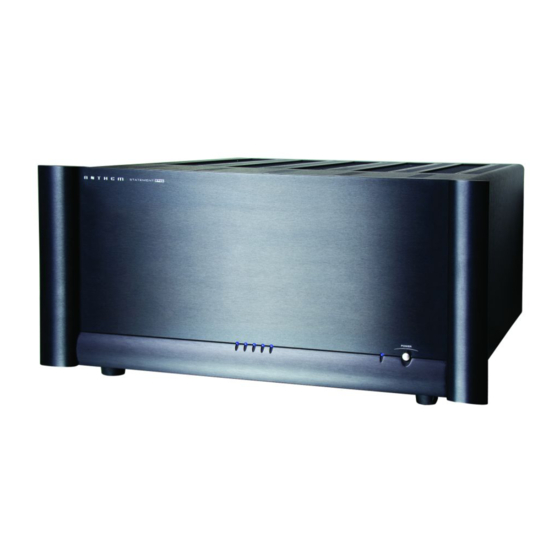
Anthem Statement P5 Product Review
Hide thumbs
Also See for Statement P5:
- Operating manual (12 pages) ,
- Brochure & specs (5 pages) ,
- Product review (3 pages)
Advertisement
Table of Contents
P R O D U C T
REVIEW
"
multichannel audio of the highest order.
B Y R O G E R K A N N O
Anthem and its parent company, Paradigm, are
on a roll. Anthem recently introduced the
AVM 30 surround-sound processor, which
improves on the award-winning AVM 20 at
a price lower than its predecessor's. The
Anthem Statement D1 surround-sound
processor is even more impressive, and
Paradigm's new Reference Signature line of
speakers is earning rave reviews.
To complement these new processors and
to provide the high-quality amplification
required to get the most out of the Reference
Signatures, Anthem has introduced several
new power amplifiers in their Statement line
of electronics. I was provided the Anthem
Statement P5 five-channel power amplifier
as part of a top-of-the-line Anthem-Paradigm
home-theater system that included the
Statement D1 processor and Paradigm
Reference Signature speakers, the S8,
C5, Signature ADP, and Signature Servo
subwoofer.
P5
... simply spectacular ...
THE ULTIMATE STATEMENT
The first thing I noticed about the Anthem
Statement P5 is its size and mass. It weighs
130 pounds, and its shipping box would
not easily fit into the hatch of my car —
I solicited the help of a coworker with a
strong back and a pickup truck to transport
it. Many large audio/video components
have warnings on the packaging that
recommend they be moved by two people,
but with the P5 it was a necessity. Along
with the P5's enormous mass comes a
rock-solid build quality that, while not
necessarily an indication of sonic per-
formance, will instill the utmost confidence
in its durability.
The P5 is a multi-mono design, each
channel of amplification residing on a
separate circuit board with its own
heatsink and, more important, its own
power supply. This minimizes the inter-
ference between channels for enhanced
performance and ensures that all channels
can simultaneously be driven to their
maximum rated output. The major draw-
back of this type of design is the added
cost of providing sufficiently large power
supplies so that each channel can inde-
pendently deliver its rated output. Because
of the need for these large separate power
supplies, there are relatively few mono-
design multichannel amplifiers on the
market. Those that are available typically
have lower output ratings than similarly
priced amplifiers that share common
power supplies and can shunt power as
required to any channel — which is why
such amps' power ratings are often
specified for only one or two channels
driven. However, the P5 is rated at 325Wpc
into 8 ohms, 500Wpc into 4 ohms, and
675Wpc into 2 ohms, all channels driven.
The P5 is said to be stable down to a short
circuit at full output. Judging by these
power ratings and its tremendous build
quality, you begin to get an idea of just
how serious an amplifier the P5 is.
"
Advertisement
Table of Contents

Summary of Contents for Anthem Statement P5
- Page 1 The first thing I noticed about the Anthem maximum rated output. The major draw- AVM 30 surround-sound processor, which Statement P5 is its size and mass. It weighs back of this type of design is the added improves on the award-winning AVM 20 at...
- Page 2 … various PVC instruments and and voltage to ensure the P5’s long life. Anthem claims that ALM drums sounded distinctly different from one is “totally non-invasive,” engaging only in the most extreme circumstances, to protect the amplifier from damage.
- Page 3 Simaudio Moon Aurora (five-channel version), the Bel Canto eVo6, and the Anthem Statement P5. Although each amplifier had, to some extent, its own “personality,” they were actually more similar than not. As you might have guessed, the P5 was the most powerful of the three, and sounded it.




Need help?
Do you have a question about the Statement P5 and is the answer not in the manual?
Questions and answers